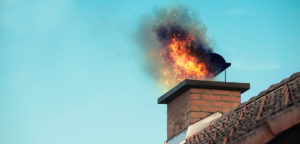
The fireplace may be a happy spot for the family to gather ‘round. But did you know that fireplaces and chimneys caused 23,100 residential fires in the United States in 2013—and that those blazes caused $109.1 million in property damage and 10 fatalities?1
Statistics like these drive home the importance of scheduling an annual chimney inspection. Ashley Eldridge, director of education at the Chimney Safety Institute of America (CSIA), says that even homeowners who don’t use their fireplaces should spring for an inspection. That’s because a home’s other heating devices also release toxic gases through the chimney; when debris clogs its escape, those harmful fumes remain in your home.
“Preventative measures are typically much less expensive than repairs when you have a crisis,” Eldridge says. “It just makes sense to be ahead of the curve.”
Why a chimney inspection?
An inspector can check for one big culprit of chimney fires—creosote, which is a thick, gummy substance that’s a byproduct of burning wood. Creosote causes most chimney fires, including one recently inspected by ERIE Property Adjuster Sandi Benes. That chimney’s creosote buildup caused a blaze that destroyed $23,000 worth of property. How’d it happen? The homeowner decided to clean out his chimney on his own.
To reduce the risk of a creosote-caused fire, Benes recommends hiring a pro and burning only designated firewood. “Burning green wood or soft wood with resin in it increases creosote buildup,” she explains.
Chimney inspections usually cost between $100 and $300 and fall into one of two levels.
Level One Inspection
During a level one inspection, the inspector will spend about an hour to measure all the readily accessible components of the chimney, like the size of the firebox and the clearance from the stove. From there, he or she will decide if your chimney needs a sweep.
A chimney merits a sweep for a number of reasons, but the main ones include debris blocking the air ducts and creosote build-up. “Birds and squirrels are a very real issue,” says Eldridge, who has also seen everything from clumps of leaves to basketballs stuck in chimneys. “Animals can set up camp in there, and it can be really unpleasant.”
Debris that’s not removed is a big risk factor for causing a fire or trapping poisonous gases like carbon monoxide in your home. Besides an annual chimney inspection, it’s also worth checking out a chimney cap. These tools fit over the flue to keep debris—as well as damaging water—out.
Level Two Inspection
A more thorough level two chimney inspection is a worthwhile investment for new homeowners who haven’t had a level one inspection. A level two inspection requires the chimney sweep to get on the roof to makes additional measurements, such as the distance of the chimney to any combustibles.
To learn more about each level and what it entails, check out this videofrom the CSIA.
Finding a super sweep
The CSIA lists more than 1,300 sweeps who earned the CSIA Certified Chimney Sweep® Credential. This credential proves a sweep has a superior understanding of the tools, techniques and processes to get the job done right. What’s more, all CSIA-certified sweeps pledge to uphold a code of ethics.
To locate a CSIA-certified chimney sweep in your area, check out the CSIA home page. Your sweep probably won’t have a Cockney accent and a song a la “Mary Poppins.” But he or she will have the know-how to help you safely enjoy your home and hearth all winter long.
1https://www.cpsc.gov/s3fs-public/2011to2013ResidentialFireLossEstimates-Final.pdf

Recent Comments